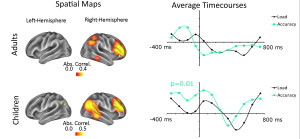 We have known for some time that the brain is composed of a set of highly integrated networks, with seemingly distant brain areas forming coordinated systems. These networks develop gradually throughout childhood, with those networks thought responsible for higher-order cognition (e.g. short-term memory, attention) showing the slowest development. Typically these networks have been studied using fMRI, a technique that measures blood deoxygenation as a proxy for neural activity.
We have known for some time that the brain is composed of a set of highly integrated networks, with seemingly distant brain areas forming coordinated systems. These networks develop gradually throughout childhood, with those networks thought responsible for higher-order cognition (e.g. short-term memory, attention) showing the slowest development. Typically these networks have been studied using fMRI, a technique that measures blood deoxygenation as a proxy for neural activity.
However, this technique is notoriously sluggish, making it difficult to study dynamic changes to these networks with this approach.
MRC CBSU researcher Duncan Astle, along with collaborating researchers from the University of Oxford, including Kia Nobre, Gaia Scerif, Mark Woolrich, Bo-Cheng Kuo and Henry Luckhoo, have shown that an alternative technique – magnetoencephalography (MEG) – can be used to explore these networks. Furthermore the resolution of this technique is such that the activity levels of these networks can be monitored in real-time. Their paper, published this week in Cerebral Cortex, shows that in typically developing children fluctuations in one particular network mirror fluctuations in children’s short-term memory performance. They could identify when in a trial sequence this network contributed to children’s memory performance, and it was in anticipation of the memory items. In short, inconsistent use of anticipatory mechanisms contributes significantly to children’s variable memory performance.
The article is published as open access and available here
The Neural Dynamics of Fronto-Parietal Networks in Childhood Revealed using Magnetoencephalography
Duncan E. Astle; Henry Luckhoo; Mark Woolrich; Bo-Cheng Kuo; Anna C. Nobre; Gaia Scerif
Cerebral Cortex 2014;
doi: 10.1093/cercor/bhu271

 MRC Cognition and Brain Sciences Unit
MRC Cognition and Brain Sciences Unit


